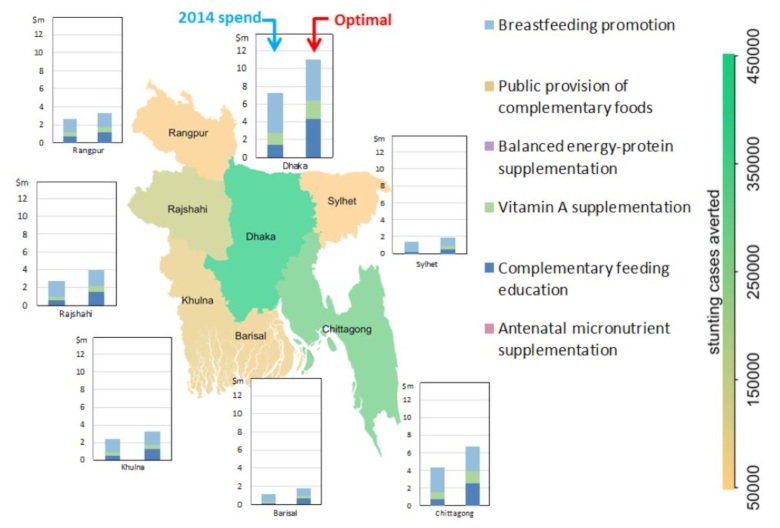Optima Nutrition is a quantitative tool that can provide practical advice to governments to assist with the allocation of current or projected budgets across nutrition programs. The model contains a geospatial component to determine funding allocations that minimize stunting, wasting, anaemia or under-five mortality at both the national and regional levels.
The model has a flexible intervention set that includes a variety of micronutrient supplementation programs, infant and young child feeding education, treatment of severe acute malnutrition, treatment and prevention of diarrhoea, fortification of foods, family planning and malaria prevention interventions.
Key questions addressed:
How can a given budget be allocated across programs and/or geographic regions to minimize malnutrition and associated conditions?
- If additional funding is or will be available, which programs and geographical regions should be prioritized to receive it?
- How might trends in undernutrition change under different funding scenarios?
- How close is a country likely to get to its nutrition targets?
- with the current funding, allocated accordingly to current expenditure?
- with the current volume of funding, reallocated optimally?
- with increased funding?
- What is the minimum funding required, if allocated optimally, to meet the nutrition targets?
Figure 1: A Bangladesh example of how an additional US$10 million can be optimally allocated across regions and programs to minimize stunting

How does this help nutrition decision making?
The Optima Nutrition model can be of value to country stakeholders in several ways:
- Determining the optimal allocation of nutrition budgets for different levels of total funding.
- Projecting medium- to long-term impacts of current investments.
- Providing confidence among donors and stakeholders that funding is being used in a way that maximizes impact.
- Through its integrated analysis of long-term financial implications, the Optima Nutrition tool can help make the case for appropriate domestic investment.
What are the data needs?
The model requires country-specific data on stunting, wasting, anaemia, diarrhoea, exclusive breastfeeding, causes of maternal and child death, and demographics (population sizes, poverty), all of which are generally available from standard surveys (e.g. DHS, MICS) or online sources (e.g. UN Population Division). Additional data that typically need to be collected are the coverage and cost of each program being considered in an analysis.
How long does it take?
Data availability varies between countries and there is flexibility for shortening or extending the process in line with requirements and availability of key in-country participants. Time and technical assistance needs can range from one to four months depending on the level of stakeholder engagement.
What are the strengths/limitations, or advantages/disadvantages of this tool?
Strengths: Optima Nutrition can provide objective quantitative information for the prioritisation of nutrition programs in the context of limited funding. The model can also assist with national planning and policy development processes.
Limitations: The model is influenced by the effect size estimates of each program, which are obtained from the sparse (but growing) academic literature and are not always setting-specific. Analyses also require estimates on the costs of scaling up interventions, which have inherent uncertainty.
Training Videos
Day 1_01: Introduction to Optima Nutrition and Modelling Stunting
Day 1_03: Modelling Wasting continued, and Anemia
Day 1_04: Modelling Anemia, exercises
Day 2_01: Modelling Other Interventions
Day 2_03: Optimizations and the Objective Function
Day 2_04: Optimization Exercises
Day 2_05: Conclusions and Discussions
Day 3_01: Optimization Exercises
Day 3_03: Concluding Exercises and Discussion
For more information, please contact Meera Shekar (mshekar@worldbank.org) or Jonathan Akuoku (jakuoku@worldbank.org).

